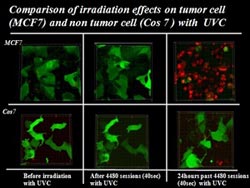New cancer therapy using ultra-violet C (UVC) pulse flash irradiation

MCF7: neoplastic cell, COS7:non-neoplastic cell. The Ultra Violet C (UVC) pulse flash irradiation only selectivity caused death of neoplastic cells, and not non-neoplastic cells. © Tokai University<br>
Johbu Itoh at the Tokai University School of Medicine in Japan has developed a new and highly effective cancer therapy method where cancer cells are irradiation with ultraviolet C (UVC) light.
The new method employs high intensity-UVC pulse flash rays (UVCPFR) of a broad UVC spectrum (230 to 280 nm) produced by a modified UV-flash sterilization system (BHX200). The experiments showed the pulsed nature of the spectrum to enhance the efficiency of destruction of neoplastic cells.
Importantly, the research demonstrates that under the appropriate UVC irradiation conditions only neoplastic cell were destroyed, and non-neoplastic cells did not reach conditions of cell death.
Background, results, and implications
The well-known “a germicidal light” of low pressure mercury lamps (UV lamp) is widely used for sterilizing medical instruments. However, it takes several hours for the weak light from UV lamps to have their germicidal effects.
In contrast, the sterilization effects of UV pulsed flash rays (wavelengths of 230–280nm and peak wavelength of 248 nm) show promise as more efficient and rapid means of destroying a wider range of bacteria because this type of irradiation produces light whose energy is tens of thousands of times greater for a given area of irradiation, compared with conventional UV lamps (65W equivalency).
UVC pulse flash rays (UVCPFR) with 1–10 continuous flashes per second can be produced by powerful discharge of xenon gas. Johbu Itoh and colleagues at the Tokai University School of Medicine has developed and established UVCPFR therapy system for cancer therapy.
The researchers irradiated cells with pulsed light UVCPFR and caused functional disorder to produce cell injury and/or a functional obstruction only to neoplastic cells. Higher ultraviolet radiation sensitivity in the UVC range was observed in neoplastic cells compared to non-neoplastic cells. That is, a short burst of ultraviolet radiation was sufficient to selectively induce injury and death to neoplastic cells.
Furthermore, experiments showed UVCPFR to cause cell death within a few seconds. One of the major features of this method is that below a certain range of irradiation conditions, damage to intact or non-neoplastic cells can be largely ignored, and only neoplastic cells die. This method offers a simple means of reducing the burden on patients undergoing cancer therapy. Itoh and colleagues plan to deveop this system compatible for cancer treatment using endoscopy, laser microscopy, and other such light irradiation equipment.
For further information contact
Johbu Itoh, Ph.D.
Dept. of Cell Biology and Histology,
Education and Research Support Center
Tokai University School of Medicine
143 Shimokasuya Isehara Kanagawa 259-1193
Japan
TEL: +81-463-93-1121 Ext.2581
FAX: +81-463-91-1370
E-mail:itohj@is.icc.u-tokai.ac.jp
References
1. Japanese patent: 4712905
2. Website of the 14th International Congress of Histochemistry and Cytochemistry (ICHC 2012), 26 –29 August, 2012, Kyoto, Japan: http://www.acplan.jp/ichc2012/ (direct link below)
Source: Tokai University School of Medicine, Isehara, Japan.
Media Contact
All latest news from the category: Health and Medicine
This subject area encompasses research and studies in the field of human medicine.
Among the wide-ranging list of topics covered here are anesthesiology, anatomy, surgery, human genetics, hygiene and environmental medicine, internal medicine, neurology, pharmacology, physiology, urology and dental medicine.
Newest articles

Bringing bio-inspired robots to life
Nebraska researcher Eric Markvicka gets NSF CAREER Award to pursue manufacture of novel materials for soft robotics and stretchable electronics. Engineers are increasingly eager to develop robots that mimic the…

Bella moths use poison to attract mates
Scientists are closer to finding out how. Pyrrolizidine alkaloids are as bitter and toxic as they are hard to pronounce. They’re produced by several different types of plants and are…

AI tool creates ‘synthetic’ images of cells
…for enhanced microscopy analysis. Observing individual cells through microscopes can reveal a range of important cell biological phenomena that frequently play a role in human diseases, but the process of…





















